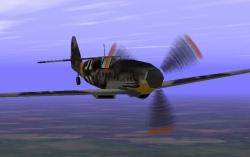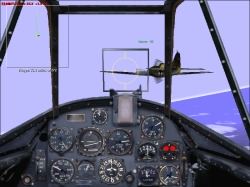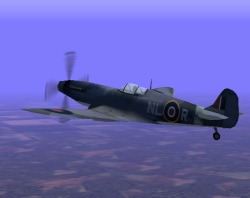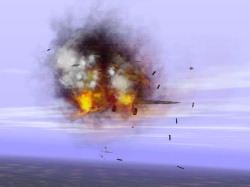| |
 he first wave of bogies has arrived, and you may be puzzling as to how to survive and fight effectively as an Ace. These modern WW2 sims are so good, that without some knowledge of tactics you will find yourself hitting the silk or outright dying more often than fun should allow!
he first wave of bogies has arrived, and you may be puzzling as to how to survive and fight effectively as an Ace. These modern WW2 sims are so good, that without some knowledge of tactics you will find yourself hitting the silk or outright dying more often than fun should allow!
Enter Ben Chiu of Strategy Plus fame. Ben has authored an amazing Guide to Microsoft's Combat Flight Simulator, chock full of absolutely excellent advice on flying and fighting in that simulation. How does that help you if you are a EAW freak? I'm glad you asked!

Let me put this in context for you. I've just finished a three hour read of Bud Anderson's "To Fly and Fight," his personal story of his journey to Ace-dom in Old Crow in 1944 in Europe. Bud fought alongside Chuck Yeagar, not as his wingman as some have mistakenly assumed, but as a squadron leader in the same outfit. Bud ended the war with close to the same number of kills as Chuck.
I finished the book shortly before picking up Ben's guide. And here is the punch line. I could swear that Ben had been flying some of those same fights!
In short, Ben's guide is possibly the best instruction anyone could ask for in order to make the best of any good WW2 prop sim. Ben realistically appraises the actual tactics used in WW2 for various types of missions, and also has a keen appreciation of the combat platforms in question.
Perhaps there was no better person to write such a guide, though it's almost a shame that this guide will likely be missed by many prop sim fans since they will assume it's application is limited. Far from it! Ben is a real life pilot and a sim fan and writer of note, and an excellent instructor via his many articles in Strategy Plus magazine. But rather than try and convince you with mere words, let's consider some samples from the Guide.
Before we get into the meat, here is the structure of the Guide. Note that the first two chapters, along with chapter ten, are limited in application to CFS.
- Chapter One: Quick Start
- Chapter Two: Preflight
- Chapter Three: Air Combat Conventions
- Chapter Four: Ground School
- Chapter Five: Primary Flight Training
- Chapter Six: Air Combat Basics
- Chapter Seven: Aircraft and Flight Performance
- Chapter Eight: Intermediate Combat Training
- Chapter Nine: Advanced Multiplayer COmbat
- Chapter Ten: Campaigns and Missions
Chapter three is where the meat will start for non owners of MS Combat Flight Sim. Incidentally, if you DON'T own CFS, I wonder why? Although it lacks the flow of EAW and the ability to issue orders to your wingmen, its a tremendous air combat simulation with excellent flight modeling. And you will be able to employ and benefit by learning the tactics of real pilots, much as you must in EAW.
Chapter three begins with a discussion of the forces of flight and then begins to get into the meat of air to air combat with a look at pursuit paths and deflection angles. I was surprised to see that the chapter then flows into a discussion of flights and elements! Good grief, I began to wonder if Ben wasn't in the RAF in another life!
Ben is very methodical in his discussion, like a good teacher he lays precept upon precept, building a foundation for understanding flight and joint tactics. Diagrams abound, helping to illustrate the various concepts.

Chapter Four continues with Ground School, launching first into a discussion of Situational Awareness. Although the discussion of views is specific to CFS, the application is much more broad since the view structure in other WW2 sims is comparable. From here Ben proceeds to a discussion of the various instruments in the cockpit and how to use them. The latter part of this chapter covers use of throttle, stalls and spins, turn coordination and the like.
Chapter Five, Primary Flight Training, is kind of an expansion of various check lists. From pre-flight to takeoff, from cruise to descent and landing, Ben leads the reader through the general checks that will contribute to a safe and successful flight.
Click to continue
. . .
|
|

For readers who feel confident in these early sections, (probably a minority of us if the truth be told), chapters Six to Nine will hold the greatest interest. Ben has broken these chapters into specific areas of instruction. One vs one tactics are discussed in Air Combat Basics. Multiple fighter tactics are discussed in the Advanced Cobat Training. Bomber tactics are discussed in the Intermediate Training chapter.
In chapter Six ben breaks one vs one into four stages: Detection, Closing, Attack, and Disengaging. This is a detailed discussion loaded with tips from a very experienced combat sim pilot. Here is one example from the "Detection" discussion.
"One maneuver that's effective for detection purposes at high altitudes is a forward slip. It allows you to bank your wings without changing your heading. While a forward slip is normally used for losing altitude, a less aggressive slip (using less control input) doesn't cause an appreciable loss of altitude.....
Basically, the forward slip is a bank using ailerons with enough opposite rudder aded to keep the airplane from turning. You'll usually need to apply a bit of up elevator to keep the aircraft from descending as well. It may take a little getting used to, but with some practice the slip will become second nature."
And another tip from the "Closing" discussion....
"Before closing on the enemy, make note of the bearing of important landmarks. In particular, note where friendly territory is located in relation to where your fight will take place and the direction of your mission objective(s). This means knowing the heading of your charges in an escort mission or direction of your mission target. When things get busy.... it will save you from having to waste time during battle just to figure out where to find help or safety."
Under the "Attack" stage Ben has included a very detailed discussion of attack manouvers. From the Boom 'n Zoom to Reversals, tactics are covered in detail, and integrated with a discussion of the use of key forces like gravity to improve performance. Other gems found in this section include avoiding the overshoot, making use of the early turn, using lift vector to your advantage, and loop fighting. The chapter ends with damage management.

Chapter Seven on Aircraft and Flight Performance comes complete with detailed charts covering maximum instantaneous and sustained turn rates for the aircraft modeled in CFS. This chapter includes discussion on the use of flaps, torque effects, and g issues. Finally, armament and lethality are discussed.
Chapter Eight brings us back into the meat of things with Intermediate Combat Training. If you've wondered what a stern conversion tactical intercept is, this is where you will find out! Where you are flying an escort mission, a strike mission or close air support, the tips in this section are excellent and based on actual WW2 combat experience. Ben has done his research well!

Finally, chapter nine brings us to a consideration of multiplayer combat, where you will face the most wily and deadly enemy ever: other human pilots! Ben brings his wealth of online experience to bear here and discusses the best offensive and defensive tactics, including wingmen and squadron tactics.
Again, diagrams are frequent and helpful.
In short, this work is top notch and I recommend it without hesitation to all WW2 combat pilots.
|
|

 he first wave of bogies has arrived, and you may be puzzling as to how to survive and fight effectively as an Ace. These modern WW2 sims are so good, that without some knowledge of tactics you will find yourself hitting the silk or outright dying more often than fun should allow!
he first wave of bogies has arrived, and you may be puzzling as to how to survive and fight effectively as an Ace. These modern WW2 sims are so good, that without some knowledge of tactics you will find yourself hitting the silk or outright dying more often than fun should allow!




